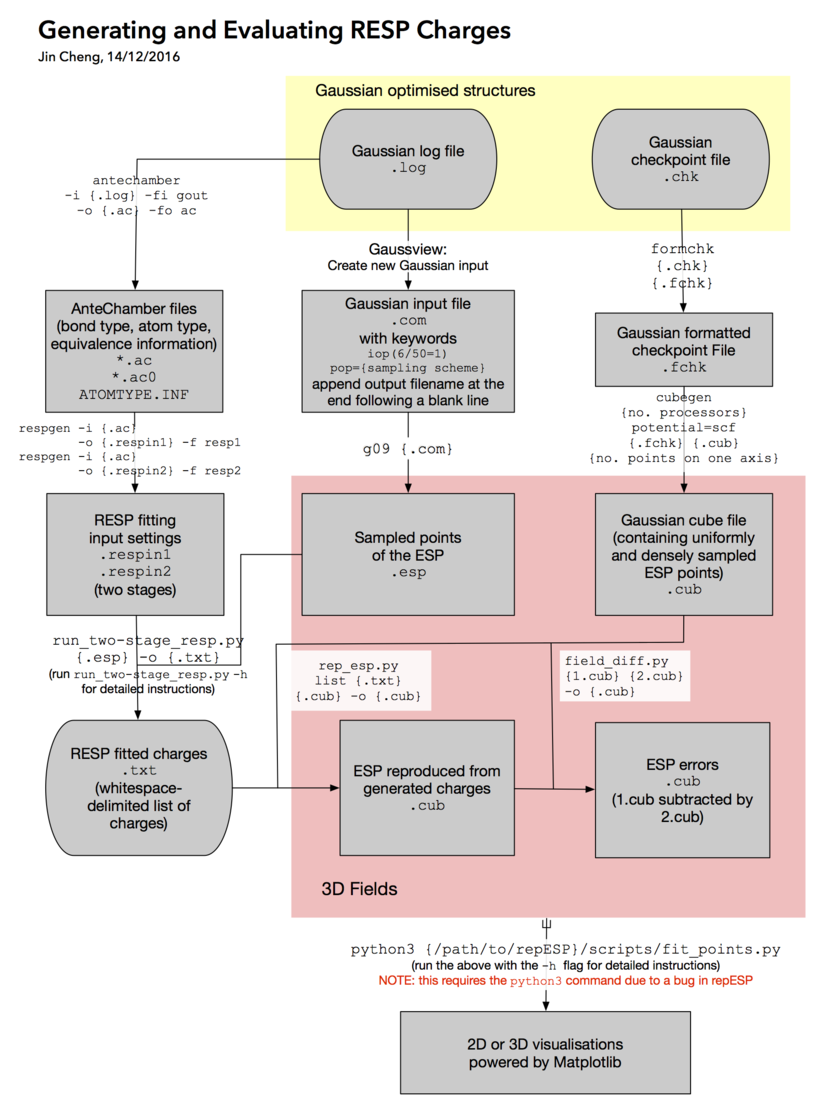Mod:Hunt Research Group/Charges
Work in progress.
This article outlines how to obtain NBO, ESP and RESP-fitted charges.
Overview
There are two main classes of charge assignment methods: one by the partitioning of orbitals and one by statistical fitting of the electrostatic potential (ESP).
The former class includes the popular Mulliken population analysis (MPA), Lowdin orbital population analysis, and natural bond orbital analysis (NBO). There are also variations on MPA. Many of these are supported by [http://www.gaussian.com/g_tech/g_ur/k_population.htm Gaussian]. Comparing across these orbital-based methods can lead to conflicting conclusions and there is no general consensus regarding which is the most accurate, although it is widely agreed that MPA is perhaps the least accurate. Nonetheless MPA is calculated by Gaussian by default after every structural optimisation.
The latter relies upon statistical analysis on the true ESP of the molecule, by minimising the root-mean-square deviation of the reproduced ESP from the point charges. RMS error is a way to quantify statistical quality of such assignment but an alternative one, the relative RMS, divides the RMS error by the overall molecular charge and is a better measure of quality for charged species.
Averaging vs. Equivalencing
Many bonds rotate faster than the MD timescale and therefore in this context, some atoms can be equivalent to each other. An example of this is the methyl hydrogens, where removing conformational dependence at the methyl produces chemically relevant charges.
Gaussian population analysis does not account for the equivalence of atoms. Charges on equivalent atoms can be a priori averaged so that these charges make more sense when analysed.
A better method is to introduce equivalence before the charge assignment process, which is done by the Restrained ESP fitting method. RESP also does one additional step of ESP fitting in which only hydrogen atoms are allowed to optimise and the heavier atoms have fixed charges. By this nature, RESP charges do not need *a priori* averaging.
Sampling Schemes (ESP and RESP only)
ESP-fitting algorithms requires sampling of the true ESP around the molecule. There are many sampling schemes, the most popular of which are the Merz-Kollman (MK) and the CHelpG schemes. In some cases MK/ESP-fitted charges are more conformation independent. In general, ESP-fitted charges vary less with different sampling schemes than orbital-based charges do upon changing the orbital partitioning algorithm.
Sampled charges can stored as .esp files in the AnteChamber ESP format via Gaussian 09. However Gaussian 09 itself can do some basic ESP-fitting with the `pop=` keyword ( [(http://www.gaussian.com/g_tech/g_ur/k_population.htm) and the atomic charges can be extracted from the log file.
NBO
- After obtaining an optimised structure, run a Gaussian job with the following keywords:
pop=nbo
- It is recommended that you use the special version of Gaussian, g09/b01-nbo on the HPC for this calculation. This gaussian has been compiled with a newer version of NBO embedded.
- If you are using the special version of gaussian, the b01 version does not support the empirical dispersion keyword. You should remove the keyword from your input file.
- NBO charges can be obtained using gauss view, or read from the resulting log file.
- You can average the charges of equivalent atoms
ESP
RESP

